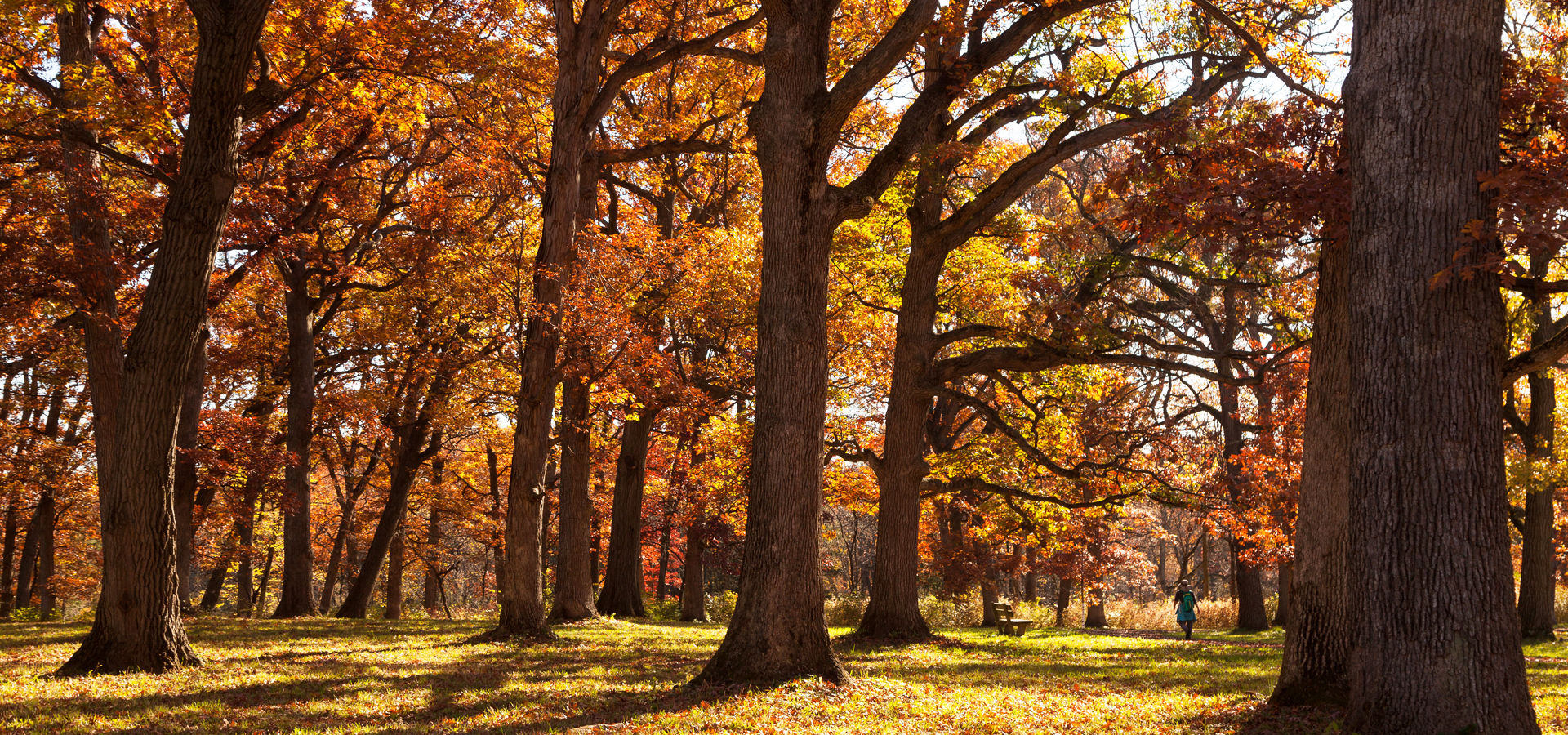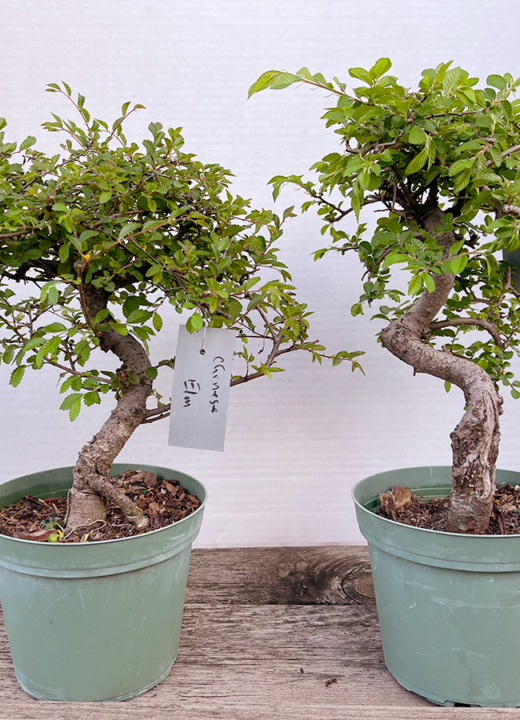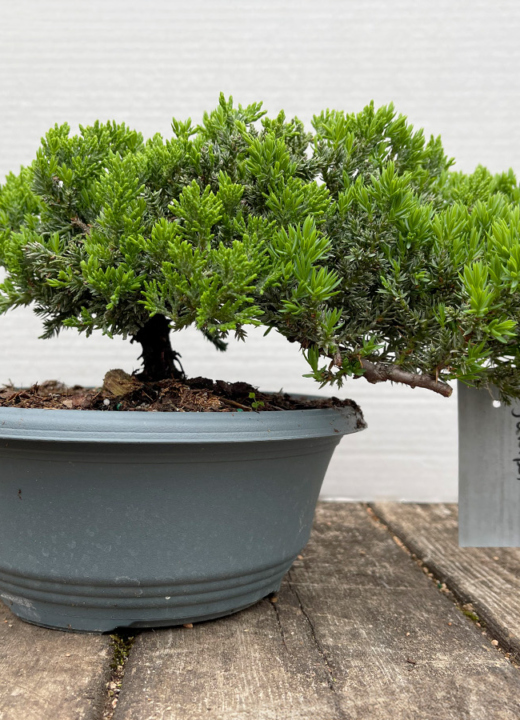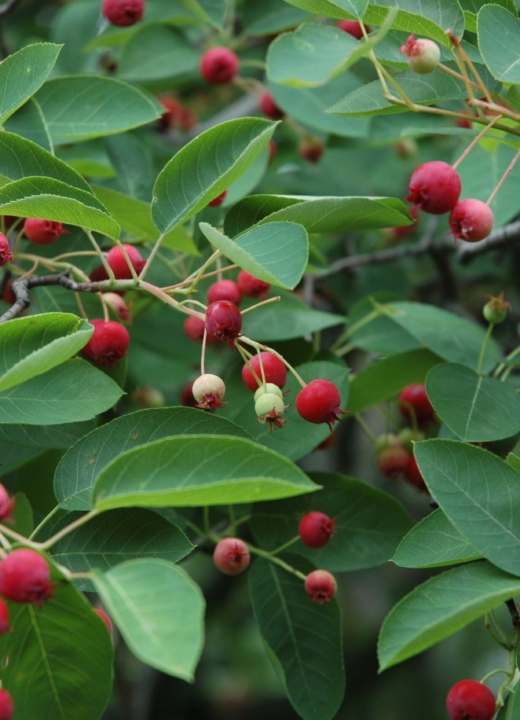1. From the Visitor Center parking lot, turn right and follow the signs for the East Side Main Route. You will skirt Meadow Lake, a man-made retention basin surrounded with trees and sweeps of native plants.
2. As you ascend a hill and bend around a curve, you will see young bald-cypress trees on your left.
- Bald-cypress or swamp-cypress (Taxodium distichum). As the book notes, this tree’s branches are bare once its feathery needles turn amber and drop in autumn. Although native to wetlands in the Southern United States, bald-cypress is hardy in the Chicago area and is commonly planted along streets.
3. From Frost Hill (Parking Lot 3, labeled as P3) you can see a lovely valley vista and several trees mentioned in the book.
- White pine (Pinus strobus). White pines are native to Wisconsin, Minnesota, Michigan, and other parts of the Eastern United States. In the 19th century, most old-growth trees were felled for lumber. As noted in the book, the white pine was a strategic factor in leading to the War of Independence, since the British Navy sought the towering trees’ long, straight trunks for ship masts.
- Norway spruce (Picea abies). As the book notes, spruce wood is used to make the soundboards of the world’s greatest violins.
- Dahurian larch (Larix gmelinii var. olgensis). This Siberian tree is a deciduous conifer from the great boreal coniferous forest described in the book. Like all larches, it loses its soft needles in fall and grows new ones in spring.
4. In the vicinity of the Rose Family collection (Parking Lot 4) grow many fruit trees that flower gorgeously in spring. Among them is the tree that stars in the Japanese cherry blossom festival.
- Yoshino cherry (Prunus × yedoensis). For more than 1,000 years, people in Japan have enjoyed sharing the sight of these trees’ spring blossoms, as the book describes.
Nearby is a large-scale sculpture, “Strata,” part of the Of the Earth exhibition of works by Olga Ziemska.
5. At the Crabapple Collection (Parking Lot 5), you can see dozens of kinds of apple trees, which are spectacular when they bloom in spring. Among them is the ancestor of domesticated apples.
- Wild apple (Malus sieversii var. kirghisorum). Geneticists have traced the descent of the apples we eat to this species, domesticated in Central Asia between 5,000 and 10,000 years ago. This species is one of about one-third of all tree species around the world that scientists have found are vulnerable or threatened with extinction.
Across the road is a handsome group of black walnut trees.
- Black walnut (Juglans nigra). These trees, native to the Chicago region, have solid, shock-resistant wood, as noted in the book. Their nuts have green hulls; the fragments, scattered by squirrels, are a familiar sight in early fall.
6. Where a road branching to the left is marked “To Exit,” stay to the right on the Main Route.
7. In the Buckeye Collection (Parking Lot 6), you can see the horse-chestnut trees described in the book and many of their relatives.
- Horse-chestnut (Aesculus hippocastanum). In its native Europe, the horse-chestnut is the source of the big seeds or “conkers” used in a common children’s game. As the book notes, it was also the tree Anne Frank saw from her window and described in her diary.
8. Next to the buckeyes is the Linden Collection, marked by a pergola shaped like a honeycomb, because bees love linden flowers. This collection includes American basswood species as well as European lindens.
- European linden or lime tree (Tilia × europaea). According to the book, in Germany linden trees have ancient associations with Freya, the Germanic goddess of spring, love, and fertility.
- Centennial™ linden (Tilia ‘Zamoyskiana’ Centennial™). Some of the young lindens here represent a new cultivar (cultivated variety). This tree, a hybrid of the European species (T. tomentosa) and American species (T. americana), was brought to the Arboretum in 1937 as a tiny cutting from a tree in a Polish botanical garden. In 2022, using cuttings from this full-grown specimen, the Arboretum introduced this tree as a new cultivar to celebrate the 100th anniversary of its founding.
9. The Oak Collection (Parking Lot 8) is one of the world’s most comprehensive, with more than 80 species and varieties of these important trees, making the Arboretum a global leader in the science and conservation of oaks. The two European oak species mentioned in the book are not here because they are not winter-hardy in Chicago. To study and protect oaks that are native to warmer climates, such as southeast Asia and Mexico, the Arboretum collaborates with local scientists, conservationists, and public gardens in those regions. In its own collections, the Arboretum grows oak species that are sufficiently hardy for this climate.
- Maple-leaved oak (Quercus acerifolia). To the south of the road, along the trail loop that makes up the Gateway to Tree Science exhibition, is a cluster of slender saplings. They represent efforts to conserve this rare, endangered tree species that is native to Ouachita Mountains in Arkansas. By growing the maple-leaved oak in its Oak Collection, the Arboretum helps preserve this species.
10. At the next sign that says “To Exit,” turn left to take a shortcut looping back toward the Visitor Center. You are now passing through the Arboretum’s East Woods, one of the Arboretum’s major natural areas. Ongoing restoration efforts here support a native ecosystem in which the keystone species are oak trees, maintaining a web of life that includes many other plants and animals. Much of the brightest fall color in these woods comes from sugar maples.
11. Where another road merges from the right, stay to the left. A large sugar maple on the left heralds your arrival at the Maple Collection, and a sculptural specimen of weeping European beech marks the Beech Collection. Both can be explored from Parking Lot 14. In a short walk along the wood-chipped path, you can see many species and cultivars of both maple and beech.
- Sugar maple (Acer saccharum). In a Midwestern autumn, native sugar maples have the largest role in creating the tapestry of tree color. Sunny days and cool nights bring the most vivid hues.
- Tortuosa European beech (Fagus sylvatica ‘Tortuosa’). This cultivar was selected for its interesting twisted limbs. As noted in the book, the name and smooth bark of all beeches has a long association with books and writing.
- American beech (Fagus grandifolia). Native to eastern North America, this is a large, graceful tree whose leaves turn gold in fall.
You can also enjoy the nearby “Oculus,” another sculpture in the Of the Earth exhibition.
12. Where another road merges from the left, stay to the right. The road will lead past the Appalachian Collection to a group of collections of plants from Asia. If you park at the China Collection (Parking Lot 17) and walk ¼ mile down a gravel road, you will see on your left a group of mature bald-cypresses.
- Bald-cypress or swamp-cypress (Taxodium distichum). These trees, growing by the East Branch of the DuPage River, have developed the distinctive raised “knees” described in the book, whose function is still a puzzle to scientists.
On the way back, stop to admire a tree that gives a distinctive zing to some Chinese cuisine.
- Szechuan pepper (Zanthoxylum simulans). According to the book, tasting the spice derived from the seeds of this tree (which is unrelated to the chile pepper) “is like licking one’s tongue across a 9-volt battery.”
13. As you proceed along the road, you will see a row of handsome ginkgo trees to the right.
- Ginkgo (Ginkgo biloba). This Asian tree, the only surviving species of an ancient group of trees known from fossils 170 million years old, is easily recognizable by its fan-shaped leaves. Although widely planted in cities, Ginkgo biloba is now endangered in its native habitat.
14. The Arboretum’s Elm Collection (Parking Lot 18) is one of the most comprehensive in the world, including species from temperate regions of North America, Europe, and Asia. Trees from this collection were the foundation of the Arboretum’s tree breeding program, begun by researcher Dr. George Ware in 1972 in response to Dutch elm disease. One of the most successful introductions from this program can be seen here.
- Accolade® elm (Ulmus davidiana var. japonica ‘Morton’). This cultivar was introduced to horticulture by The Morton Arboretum. Selected from an Asian species in the Arboretum’s collections, the Accolade® elm grows well in urban conditions and is resistant to the Dutch elm disease described in the book. Hundreds of thousands of these elm trees are now thriving across the Chicago region, the United States, and the world.
- American elm (Ulmus americana). This collection includes stately American elms like the ones that once lined many American streets. These trees are regularly treated with insecticides to protect them from Dutch elm disease.
In this area, you also can find a tree species that, like elms, does well in low, moist spots: the one that powers the caterpillars that spin silk.
- White mulberry (Morus alba). This tree from eastern China is the preferred food of silk-moth caterpillars, as the book states. It was brought to the United States in hopes of starting a silk industry here, but most of the world’s silk still comes from China.
15. From this point, you can return to the Visitor Center, exit to Illinois Route 53, or continue on the Main Route under the highway to tour the collections on the Arboretum’s West Side. The Arboretum has nine miles of roads, 16 miles of trails, and thousands more kinds of trees to explore!
Curious about the identity of any tree you see in the Arboretum’s collections? Look for a plant label attached to the trunk or a branch at about eye level on the south side, or, on smaller trees, attached to a lower metal stake.



































































































